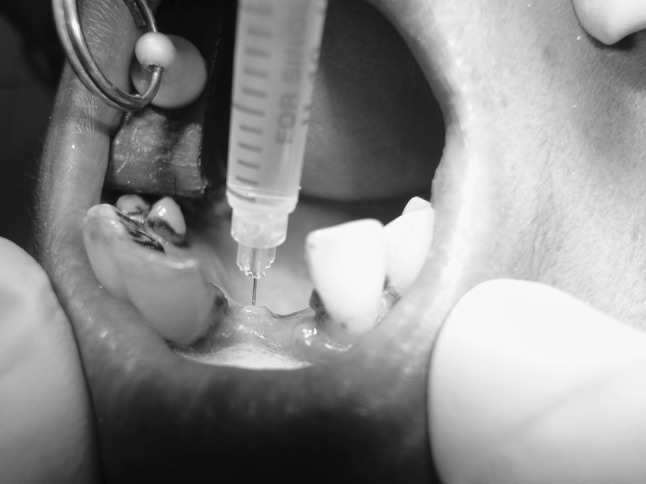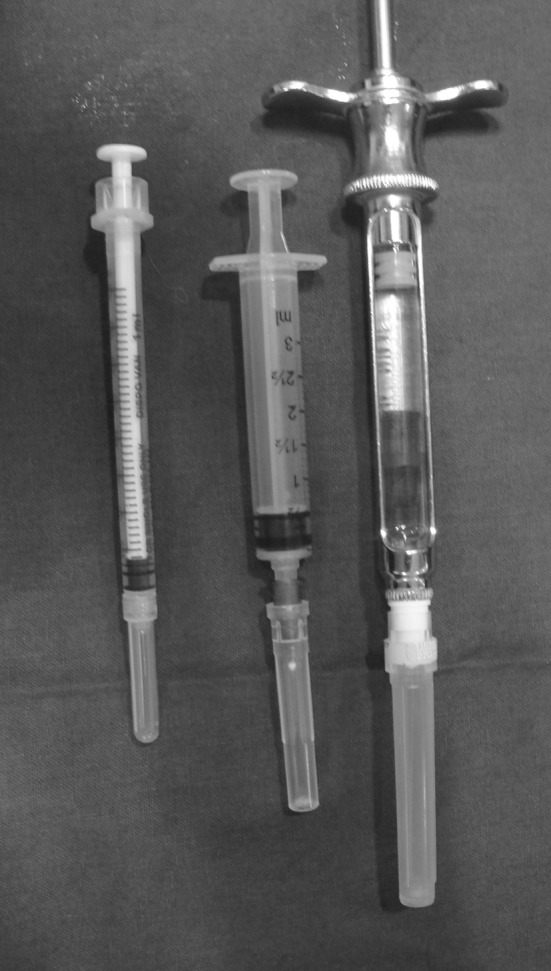Abstract
Aim
This study was conducted to compare and evaluate the pain associated with administration of Nasopalatine blocks using a disposable insulin syringe and the conventional disposable 3 mL syringe.
Materials and method
Forty patients requiring intraalveolar extractions of maxillary central incisors were randomly assigned to two groups of 20 patients each; one (Group A) received the nasopalatine block with a standard 3mL syringe and the other (Group B) received the block with an insulin syringe. Patients were asked to rate the pain associated with the injection on a visual analog scale (VAS) and the results were analysed using a Chi Square Test.
Results
The mean VAS score for Group A and B was 1.55 and 1 respectively. Chi Square value was calculated to be 8.603 (degree of freedom= 3, P value= 0.0351). There were no differences in the effectiveness of anesthesia between the groups.
Conclusion
Pain associated with administration of the nasopalatine blocks may be significantly mitigated by using the Insulin syringe.
Keywords: Nasopalatine nerve block, Incisive nerve block, Local anaesthesia
Introduction
Injection of local anaesthetics into dense tissues such as those of the palate is a traumatic experience for most patients, and this is most exemplified by the nasopalatine block [1]. When injecting using the standard syringes, the operator encounters significant resistance. To overcome this, one needs to apply more pressure on the plunger to deposit the solution. This results in the production of higher pressures within non resilient tissues, leading to pain, ischemia and possible tissue damage [1].
At our center, a disposable insulin syringe with a low dead space integral 30 gauge 8 mm long needle is frequently employed for administration of intralesional injections in patients with oral submucous fibrosis. Since injections into fibrosed buccal and retromolar tissues could be made with relative ease, it was elected to explore its possible use for painless administration of the nasopalatine block.
Materials and Method
Forty patients reporting for intralveolar extraction of maxillary central incisors were selected for the study. A detailed case history was taken for each patient. Patients who were highly anxious, medically compromised, uncooperative, as well as those with poor verbal communication were excluded.
The patients were randomly assigned to one of the two groups, A and B. Patients in Group A received the nasopalatine block with a standard 3 mL syringe (Unolok, Hindustan Syringes & Medical Devices Ltd, Faridabad. India.) to which a 26 gauge, ½ inch Luer lock needle was attached, whereas patients in Group B were administered the block using an insulin syringe with an integral low dead space 30 gauge 8 mm length needle (Dispo-van, Hindustan Syringes & Medical Devices Ltd, Faridabad, India).
Method of Administration
Intraoral preparation of the site of injection was done by povidone iodine solution and a 5 minute rinse with 0.12 % chlorhexidine gluconate. Patients were kept in a supine position with the head tilted up and back without hyperextension. After cleaning and drying the region, topical anaesthetic (20 % benzocaine) was applied to the incisive papilla for 2 min. Firm pressure was applied on the palatal tissue adjacent to the papilla using a sterile cotton bud or a gloved finger. After 30 seconds, the incisive papilla was penetrated with the syringe held parallel to the long axis of the maxillary central incisors. Immediately upon insertion, few drops of the anaesthetic (Lignocaine 2 % with 1:100,000 epinephrine) were deposited. After another 30 seconds, the needle was advanced with gentle rotation to a depth of 5 mm. 1 mL of the anesthetic solution was slowly injected over 1 minute after ensuring negative aspiration (Fig. 1). Post injection, the needle was maintained in position for several seconds to allow the fluid pressure to dissipate [2]. Procedures were carried out by a single operator in all the cases to avoid inter operator bias.
Fig. 1.

Nasopalatine block being administered using the insulin syringe. Note the tissue blanching as the solution is gently deposited
All patients were explained about the visual analogue scale (VAS) and were asked to rate the pain on the VAS on completion of the procedure. Instrumentation to confirm the effectiveness of anesthesia was carried out by an independent observer using a sharp probe applied to the palatal gingival sulcus of central incisors on both sides of the midline.
VAS scores of the two groups were analyzed and compared by a Chi Square Test, calculated with the Interactive Chisquare Test software™ (Developed by Kristopher J. Preacher PhD, Vanderbilt University).
Results
A total of 40 patients (15 females, 25 males) participated in the study with a mean age of 48.35 years. Each group consisted of 20 patients. Male to female ratio was 5:3. Table 1 shows the specific VAS score of the patients in the two groups.
Table 1.
Specific VAS scores of the patients in group A and B
| VAS 0 | VAS 1 | VAS 2 | VAS 3 | VAS 4 | VAS 5 | |
|---|---|---|---|---|---|---|
| Group A (n = 20) | 1 | 8 | 10 | 1 | 0 | 0 |
| Group B (n = 20) | 7 | 8 | 3 | 2 | 0 | 0 |
The mean VAS score for Group A (patients receiving block with 3 mL syringe) was calculated to be 1.55 and that of Group B (patients receiving block with insulin syringe) was calculated to be 1. The chi square value was calculated to be 8.603 (degree of freedom = 3, P value = 0.0351). Pain associated with the injection in group B patients (insulin syringe) was thus significantly low.
Discussion
The area supplied by nasopalatine nerve includes the anterior palatal mucoperiosteum; specifically the inter cuspid region and the antero inferior part of the nasal septum. Nasopalatine blocks are normally employed for carrying out soft tissue procedures in the above regions and as supplemental anesthesia for extraction of upper six anterior teeth [3]. The block is generally administered using a dental cartridge holding syringe or a disposable 3 mL/2 mL syringe and is by and large regarded as a very painful injection [1, 3]. Pressures generated by conventional syringes have been shown to be as high as 600 psi or even more [1]. The density of tissues and the need to penetrate a compact neurovascular bundle have been cited as the most probable reasons for this extreme discomfort. Various alternatives proposed to circumvent this problem include:
Preparatory injections through the interdental papilla between upper central incisors [1, 3]. This obviously means additional punctures and the trauma and discomfort of multiple injections for the patient. Jet injectors have also been recommended for preparatory anaesthesia, but their use may be associated with post injection soreness [1].
Palatal infiltration bilaterally. The density of tissues here is as much as in the region of the papilla itself. Pain therefore is not appreciably lower and again multiple injections are required to render the entire premaxillary palate numb.
Computer Controlled Local Anaesthetic Delivery (CCLAD) devices [1]. These have received the maximum attention and popularity. The drug delivery is at a preset rate and controlled by the computer, while the operator focuses on needle placement alone. Since deposition of the solution is extremely slow, these devices have been effective in achieving a near painless administration of the block. The CCLAD devices are however expensive and not practically implementable in third world countries.
The exact fluid dynamics produced by a computer-controlled motor are difficult, if not impossible, to reproduce manually with a syringe [1]. However, if it were possible to control pressure and rate of local anaesthetic delivery with the use of non conventional manual syringes, it should be possible to mitigate pain and render the nasopalatine block more acceptable to the patient.
With this intent, the insulin syringe was evaluated for the purpose. Even though a thinner (30 gauge) needle was used on the insulin syringe, as compared to the standard disposable syringe (26 gauges), it is likely that lower pain perception in the former was not due to the needle itself. Multiple studies have demonstrated that the perception of needle-stick pain from 25, 27 and 30 gauge needles are indistinguishable [2]. We believe that it is the design of the insulin syringe which allows a more graded, controlled and fractionated administration without the need for excessive force on the plunger.
The disposable insulin syringe (Fig. 2) has a much smaller calibre, and can accommodate 40 units of insulin or 1 mL of solution. The calibrations are marked at 0.025 mL intervals, and therefore a lesser quantity of solution is dispensed per unit length movement of the plunger (0.017 mL/mm), when compared to the disposable 3 mL syringe (0.05 mL/mm) or the cartridge holding syringe (0.03 mL/mm). This has the following advantages:
The quantity of solution delivered per unit length movement of the plunger is about 1/3rd of that delivered by a 3 mL disposable syringe and nearly half of that delivered through a standard cartridge holding syringe. One can therefore administer the block without any excessive pressure on the plunger.
The calibrations at 0.025 mL intervals allow fractionated and controlled administration which can be visually monitored. This is in contrast to the 2 mL/3 mL disposable syringes which have calibrations at 0.1 mL intervals, or the cartridge syringe which has no calibrations at all. Lesser quantity of the solution can thus be slowly expelled into the tissues, minimising tissue distension, mitigating pain, and reducing the risk for local ischemia and tissue necrosis.
Fig. 2.

Note the much smaller calibre of the insulin syringe when compared with the dental cartridge syringe and the disposable 3 mL syringe. This allows for more controlled and fractionated administration, and lesser force and pressure to expel solutions into dense palatal tissues
In the authors’ experience, preparatory injections were not required. However we believe that application of a small amount of topical anesthetic to the injection site prior to needle penetration is an integral step in the delivery of atraumatic injections, and this was practised in both the groups under study.
Difficulty in aspirating blood with a 30 gauge needle may be cited as a limitation in the use of this device, but this point is controversial and the risk for positive aspiration in a nasopalatine block in any case is very low (1 %) [1].
Conclusion
The single use insulin syringe is comfortable, cost effective and easily procurable. Through facilitation of a controlled rate of local anaesthetic administration, it permits a near painless administration of the nasopalatine block without the need for preparatory injections. The slender syringe with a fine and short needle has the added benefit of good tactile control, and may also appear less threatening to the patient. Insulin syringe and CCLAD devices have not been compared and therefore we cannot comment if the degree of operator and patient comfort is similar or different. However, we would recommend the use of insulin syringe as a relatively painless alternative to the standard manual devices used for administration of nasopalatine block. A possible extension of this philosophy of using insulin syringe with an integrated low dead space 30 gauge needle could be its application in P-ASA (palatine approach to anterior superior alveolar nerve block), anterior middle superior alveolar (AMSA nerve block) and periodontal ligament (PDL) injections. This is a subject for further evaluation.
Conflict of interest
None.
Funding
None.
Ethical approval
Not required.
References
- 1.Malamed SF. Handbook of local anesthesia. St Louis: Elsevier; 2004. [Google Scholar]
- 2.Friedman MJ, Hochman MN. P-ASA block injection: a new palatal technique to anesthetize maxillary anterior teeth. J Esthet Dent. 1999;11:63–71. doi: 10.1111/j.1708-8240.1999.tb00380.x. [DOI] [PubMed] [Google Scholar]
- 3.Bennet CR. Monheim’s local anesthesia and pain control in dental practice. New Delhi: CBS; 1990. [Google Scholar]


